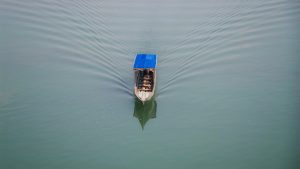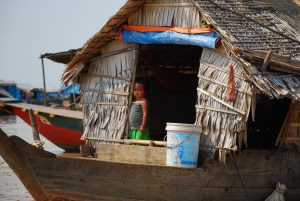49 SE Asia: Physical Geography I – Tonlé Sap
In Khmer language, Tonlé means freshwater and Sap means lake.
Thus, we should not say Tonlé Sap Lake, as Sap already means lake.
However, Cambodia also has the Tonlé Sap River, which connects the lake to the Mekong River. Ok, so maybe it’s confusing, but if we only write Tonlé Sap, then we are referring to the lake.
M is for Mekong

Although the Mekong River does not directly connect to Tonlé Sap, this mighty river of SE Asia does so indirectly, through the intermediary river (yes, you guessed it), the Tonlé Sap River. In introducing SE Asia, we have noted the predominance of water – coastal and river. While there are other rivers in SE Asia (Red River, for one), the Mekong River is the dominant waterway of the region. Indeed, it is crucial for landlocked Laos; however, while Cambodia has coastline, the importance of the Mekong River to this country dwarfed that significance of its coastal areas along the Gulf of Thailand. Cambodia’s seventh largest city Sihanoukville is its largest coastal city with about 75 thousand people. In contrast, Cambodia’s primate city Phnom Penh with over two million people is located at the confluence of the Mekong River and the Tonlé Sap River. As you will see with an explanation of Tonlé Sap’s seasonality, this location directly involves the lake, the Mekong River, and Phnom Penh.
S is for Seasonality
Tonlé Sap is quite unusual in terms of its season changes in flow and in size. Rainfall patterns in Cambodia follow the monsoons. During the wet season of the monsoon rains, typically May/June to October/November, heavy precipitation causes the Mekong River to swell in volume. Additionally, streams throughout Cambodia increase in size and flow. A few of these smaller streams, such as the Peam, Chas, and Sen, drain directly into Tonlé Sap. Additionally, the Mekong River adds water from snow melt in its higher elevations. Overall, the Mekong River gains so much water that it partly drains into the Tonlé Sap River, thus commencing to flow into the lake. The Mekong’s peak during the wet season may be ten times the volume of the dry season. With all these fluid inputs, the lake enlarges in volume, surface area, and depth. The depth of the lake may range from 3 to 45 feet from dry to wet seasons, while its surface area varies from 2500 km2 to 16000 km2. The lake’s landscape is like a basin, so its floodplain is extensive. As the lake’s volume and depth increase, the waters easily flood horizontally in these lowlands, including a stretch to Phnom Penh itself.
Eventually, the monsoon season ends, bringing the arrival of several dry months. The Mekong River reverts to what may seem to be a normal size and pace, no longer exerting pressure on the Tonlé Sap River. This change in the Mekong prompts the Tonlé Sap River to reverse its direction, as now the force of the lake pushes water down the river and into the Mekong. In doing so, Tonlé Sap drains from its large volume until the water pressure equalizes. By that point, the lake is much smaller and quite shallow.
F is for Freshwater
Tonlé Sap is the largest freshwater lake in SE Asia. A saline lake has a noteworthy concentration of salt in its water. In the United States, we think of the Great Salt Lake in Utah and the Salton Sea in California. There are a variety of these lakes across the world, but often these lakes are not particularly useful – sometimes good for mineral extraction, but often not for fish and biology.
In contrast, freshwater lakes are incredibly numerous (millions) and spread across most of the world, at least not counting desert locations. Freshwater lakes have great economic value from fishing, transportation, tourism, and more. Given that the lake is fed by several rivers, but more than half by the Mekong River, while all of these streams are fed by rainfall and/or snowmelt, indeed Tonlé Sap is freshwater.
When the waters of Tonlé Sap have drained during the dry season, fresh layers of silt are deposited on the then drying floodplain. If this were a saline lake, the draining lake would leave behind fresh layers of salt. Silt or salt? The silt provides fertile agricultural fields, while salt would leave the land toxic for plants. Indeed, fields planted in this floodplain have a long history of excellent crop yields, including rice.
B is for Biodiversity
While both fresh and saline bodies of water may feature considerable biodiversity, Tonlé Sap’ seasonal flooding creates a thriving biological site both in terms of quantity and diversity. The lake may contain as many as 300 species of fish. Some, like the black fish, breed and spawn during the lake’s high season. They stay in the lake as the waters recede, thus making them easy prey for local fishermen tending the shallower waters. In contrast, migratory catfish arrive during the wet season and then depart when the lake’s waters disperse. The catfish seeks to spawn in farther northern stretches of the Mekong River. However, many catfish are caught in the Tonlé Sap River, either coming or going.

Tonlé Sap is known for its fast-spawning and fast-growing fish stocks. By the end of the wet season, the lake is teeming with fish. Large numbers of poor Cambodian fisherman have livelihoods that depend on these fish stocks. As with fish, the lake also is teeming with boats, even to the extend of essentially creating floating villages. Annual fish catch ranges from 180,000 to 250,000 tons. Fish harvested from Tonlé Sap provide over half of Cambodian’s protein intake. Unusual, but the lake also provides the world’s largest snake harvest with nearly seven million water snakes netted each year.
Unfortunately, there are ecological problems facing Tonlé Sap. Despite the fertile fields, farmers may add fertilizer, some of which runs off into the lake. Deforestation is a concern. Hydroelectric dams being built upstream on the Mekong River may alter the natural ebb and flow of the river and the lake. Rising human population leads to overfishing and pollution.
Did you know?
MFSB was the name of a group of more than thirty studio musicians in Philadelphia. Indeed, this stood for mother, father, sister, brother. Their 1974 album “Love is the Message” featured a song titled “TSOP (The Sound of Philadelphia).” TSOP reached #1 on the U.S. Billboard Hot 100 in the spring of 1974. You can hear the tune by Googling MFSB TSOP.
Cited and additional bibliography:
Bragança de Carvalho, Mateus. Tonle Sap. photo, 24 September 2021. Unsplash, https://unsplash.com/photos/4vLmnECJYRc .
Hays, Jeffrey. TONLE SAP | Facts and Details. https://factsanddetails.com/southeast-asia/Cambodia/sub5_2f/entry-3506.html. Accessed 6 June 2022.
Wildlife Conservation Society Cambodia. Species and Habitats. https://cambodia.wcs.org/Wild-Places/Tonle-Sap-Lake-Floodplain/Species-Habitats.aspx . Accessed 7 June 2022.
Wright, Hannah. Mekong River. photo, 19 October 2019. Unsplash, https://unsplash.com/photos/ir8rtrmLkEk.




